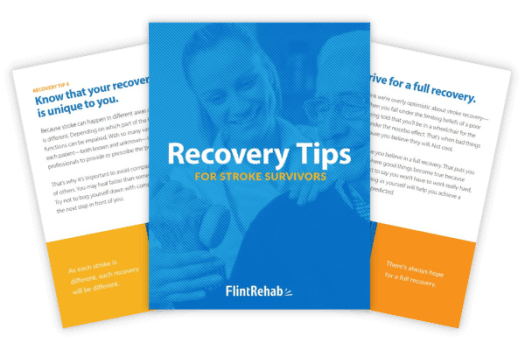

Mirror therapy after stroke is a unique rehabilitation technique that can help individuals improve mobility in the hand and arms — and sometimes even legs. The most attractive aspect of mirror therapy for stroke patients is that it is accessible to survivors with extremely limited mobility and even post-stroke paralysis.
To learn how mirror therapy for stroke patients works, it’s important to understand the role of mirror neurons and the phenomenon of neuroplasticity. This article will discuss how mirror therapy can help you improve function and the best way to practice it and promote recovery.
Use the links below to jump straight to any section:
Mirror therapy is a therapeutic intervention first introduced to help relieve phantom limb pain, which occurs when an individual experiences pain in their amputated limb. It involves using a tabletop mirror to create a reflection of your arm or hand. The mirror is placed in the middle of the body, hiding the affected side and facing toward the non-affected side, so that the non-affected side appears in the reflection.
Then, the individual uses the non-affected arm to perform various arm and hand exercises while watching the reflection in the mirror. Practicing movements with your non-affected limb while watching its mirror image (which appears to be your affected limb) moving helps “trick” the brain into thinking that you’re moving your affected arm even though you aren’t.
In amputees, numerous sessions of mirror therapy were found to reduce phantom pain by helping the brain recognize and “feel” the amputated limb. As the applications of mirror therapy expanded, similar effects were also seen in individuals with pain and/or sensation deficits post-stroke. Furthermore, researchers found that mirror therapy is especially effective in helping to improve movement in the affected limb(s) of stroke survivors.
One of the main reasons that mirror therapy works is due to mirror neurons. These are nerve cells that are activated by performing a movement or by simply watching a movement occur. Mirror therapy provides the visual feedback necessary to help mirror neurons fire by simply seeing the movement. As a result, your brain gets the feedback necessary to spark the rewiring process called neuroplasticity.
Neuroplasticity is the brain’s ability to heal and rewire itself after a neurological injury like a stroke. It is best activated through high repetition of therapeutic exercises, or massed practice. Neuroplasticity strengthens existing neural pathways (connections) and creates new ones. The stronger the neural pathways for a specific function become, the higher the chances of restoring that function.
After a stroke, many neural pathways become damaged or destroyed. Depending on the area(s) of the brain affected by stroke, specific functions may become impaired. Fortunately, neuroplasticity allows healthy parts of the brain to take over lost functions. For example, when the brain has trouble sending signals to the hand after a stroke, neuroplasticity allows new areas of the brain to take over hand function.
Mirror therapy is a great way to activate neuroplasticity, as it repetitively activates mirror neurons involved in affected movements. For example, consistently practicing specific movements, such as hand therapy exercises, during mirror therapy can help the brain rewire itself and strengthen the pathways that control hand function. Thus, mirror therapy can help activate neuroplasticity and promote overall recovery.
Mirror therapy is often used in rehabilitation clinics to help survivors pursue recovery, especially after a stroke. Even though it seems like a simulation, mirror therapy provides many benefits.
Benefits of mirror therapy exercises after stroke include:
Another benefit from mirror therapy is that it can be done with your therapist in a clinical setting, or it can be performed at home on your own. In the next section we’ll discuss how you can perform mirror therapy exercises after stroke safely and independently.
Mirror therapy after stroke can be practiced with the help of a therapist or on your own. The following video and instructions are provided to illustrate how to practice mirror therapy for the hands specifically. However, if you want to target arm or leg mobility, simply adjust the protocol for that limb.
Here is a video from Bob & Brad (the “most famous physical therapists on the internet”) to help demonstrate mirror therapy:
MusicGlove is a neurorehab device designed to improve hand function after stroke. It motivates you to achieve high repetition of hand therapy exercises through a fun, interactive game. Best of all, the device has been clinically proven to improve hand function in 2 weeks.
However, MusicGlove does require some preexisting movement to get started, which can limit survivors with hand paralysis from using the device. To work around this limitation, some therapists have combined MusicGlove with mirror therapy by placing the glove on the survivor’s non-affected hand.
While the survivor is practicing hand exercises with their mobile hand, the affected hand behind the mirror may eventually start to develop twitches, which is a sign of movement slowly returning due to the power of mirror neurons and neuroplasticity. Of course, this is not the way that MusicGlove was intended to work, but therapists have self-reported positive results with this approach.
Here’s a video from a clinician at Helen Hayes hospital showing a demonstration of MusicGlove:

Do you have these 25 pages of rehab exercises?
Get a free copy of our ebook Full Body Exercises for Stroke Patients. Click here to get instant access.